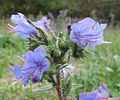| Viper's bugloss | |
|---|---|

| |
| Scientific classification | |
| Kingdom: | Plantae |
| Clade: | Tracheophytes |
| Clade: | Angiosperms |
| Clade: | Eudicots |
| Clade: | Asterids |
| Order: | Boraginales |
| Family: | Boraginaceae |
| Genus: | Echium |
| Species: | E. vulgare
|
| Binomial name | |
| Echium vulgare | |
Echium vulgare, known as viper's bugloss and blueweed,[1] is a species of flowering plant in the borage family Boraginaceae. It is native to most of Europe and western and central Asia[2][3] and it occurs as an introduced species in north-eastern North America, south-western South America and the South and North Island of New Zealand.[1][4] The plant root was used in ancient times as a treatment for snake or viper bites.[5] If eaten, the plant is toxic to horses and cattle through the accumulation of pyrrolizidine alkaloids in the liver.[6][7]
Description
[edit]It is a biennial or monocarpic perennial plant growing to 30–80 cm (12–31 in) tall, with rough, hairy, oblanceolate leaves.[8] The stems, which are red-flecked, resemble snake's skin and even the fruits are shaped like adders' heads.[9] The flowers start pink and turn vivid blue, and are 15–20 mm (0.59–0.79 in) in a branched spike, with all the stamens protruding. The pollen is blue[10] but the filaments of the stamens remain red, contrasting against the blue flowers. It flowers between May and September in the Northern Hemisphere. The Latin specific epithet vulgare means common.[5]
Distribution
[edit]It is native to Europe and temperate Asia. It has been introduced to Chile,[11] New Zealand[12] and North America, where it is naturalised in parts of the continent including northern Michigan,[3] being listed as an invasive species in Washington.[13] It is found in dry, calcareous grassland and heaths, bare and waste places, along railways and roadsides and on coastal cliffs, sand dunes and shingle.[14]
Cultivation
[edit]E. vulgare is cultivated as an ornamental plant, and numerous cultivars have been developed. The cultivar 'Blue Bedder' has gained the Royal Horticultural Society's Award of Garden Merit.[15][16]
Gallery
[edit]-
Being pollinated by skipper butterflies
-
Illustration
-
Closeup of flower
-
Colonizing the banks of a Montreal city highway
-
Extensive occurrence near Waldems-Wüstems in the Taunus
See also
[edit]References
[edit]- ^ a b Dickinson, T.; Metsger, D.; Bull, J.; & Dickinson, R. (2004) ROM Field Guide to Wildflowers of Ontario. Toronto:Royal Ontario Museum, p. 203.
- ^ Flora Europaea: Echium vulgare
- ^ a b "Echium vulgare". Germplasm Resources Information Network. Agricultural Research Service, United States Department of Agriculture. Retrieved 17 December 2017.
- ^ "Echium vulgare L." Plants of the World Online. Royal Botanic Garden, Kew. Retrieved 18 December 2022.
- ^ a b "Echium vulgare - Plant Finder". www.missouribotanicalgarden.org. Missouri Botanical Garden. Retrieved 19 September 2020.
- ^ "Guide to Poisonous Plants – College of Veterinary Medicine and Biomedical Sciences". csuvth.colostate.edu. Colorado State University. Retrieved 19 September 2020.
- ^ Klemow, Kenneth M.; Clements, David R.; Threadgill, Paul F.; Cavers, Paul B. (1 January 2002). "The biology of Canadian weeds. 116. Echium vulgare L.". Canadian Journal of Plant Science. 82 (1): 235–248. doi:10.4141/P01-058.
- ^ Graves, Melissa; Mangold, Jane; Jacobs, Jim. "Biology, Ecology and Management of Blueweed" (PDF). store.msuextension.org. Montana State University. Retrieved 22 October 2016.
- ^ "Echium vulgare - Viper's Bugloss". www.first-nature.com. Retrieved 2024-09-20.
- ^ Dorothy Hodges (1952). The pollen loads of the honeybee. Bee Research Association Ltd., London.
- ^ "Description and images of Echium vulgare (Hierba azul , Viborera , Ortiguilla), a native Chilean plant, provided by the supplier of native exotic Chilean seeds, Chileflora.com". www.chileflora.com. Retrieved 2022-11-21.
- ^ "Echium vulgare". New Zealand Plant Conservation Network. Retrieved 2020-11-28.
- ^ "Common viper's bugloss: Echium vulgare (Lamiales: Boraginaceae): Invasive Plant Atlas of the United States". www.invasiveplantatlas.org. Invasive Plant Atlas of the United States. Retrieved 22 October 2016.
- ^ Fitter, R. & A. (1974). The Wild Flowers of Britain and Northern Europe. Collins.
- ^ "RHS Plantfinder - Echium vulgare 'Blue Bedder'". Retrieved 12 January 2018.
- ^ "AGM Plants - Ornamental" (PDF). Royal Horticultural Society. July 2017. p. 35. Retrieved 24 January 2018.





